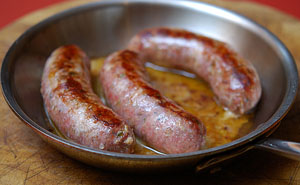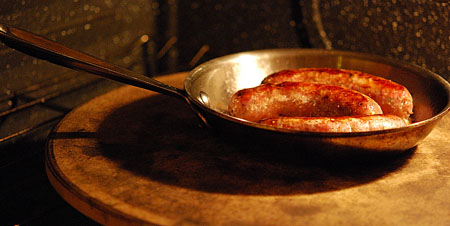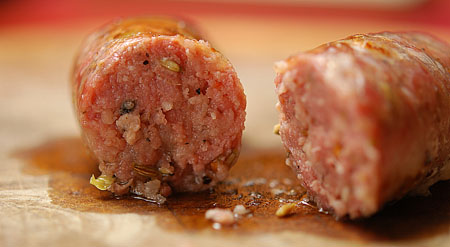As an Amazon Associate I earn from qualifying purchases.
I have been making a lot of sausages lately, and as each batch will typically give me some new insight into this craft, I have much to tell from my recent adventures.
You can learn all kinds of things from books on the subject; I recently went through a quick review of my sausage-making library. But as we all know, there is an enormous amount to learn about any subject we want to become expert at that, for whatever reason, never shows up in print. Maybe it becomes second nature to the experts, who then forget to write it down. Maybe it’s how they maintain their advantage — if you don’t tell ’em everything you know, there will always be a reason to buy from a pro, right?
Before I get into the Secrets of the Sausage (which sounds like a title for a bad porno flick), let me stop and say that these are tips best appreciated by those who have made sausage before, or who really, really care about making top-quality links.
If you’re looking for a simple primer on sausage-making, I wrote one on Elise’s site she has posted here.
My recent sausage binge started with some extra pork shoulder I had left over after making Portuguese blood sausage. I needed to use the meat before it went into the freezer, and our annual Big Fat Greek Party was coming up, so I decided to make a Greek sausage.
Whenever I am brainstorming All Things Greek , I start with Diane Kochilas’s The Glorious Foods of Greece. In it she describes all kinds of sausages, but doesn’t really bother with recipes. It’s all something like, “in Thessaly sausages have cumin and allspice,” or “Cyclades sausages have leeks and garlic.”
So I then consulted Rytek Kutas’ Great Sausage Recipes and Meat Curing or Ruhlman and Polcyn’s Charcuterie
for some details. The recipes I publish on this site are always amalgams of written recipes, ideas from authors who merely describe what seasonings go into various authentic sausages, added to my original whim. The result of this was what I am calling my Cyclades sausages, or pork sausages, Greek Islands style.
These links, as it happened, were the best of a bunch of different sausages I made for the Greek party — although I forgot to serve them at the soiree, so Holly and I have been gorging ourselves on them this week.
In addition to the pork shoulder, I also made two types of Greek lamb sausages, which I did serve, and my Thessaly-style lamb sausages turned out to be a favorite among many who ate them at the party. Another hit were the Spanish-style longaniza sausages I made from the trim of the whole goat I broke down. These were my favorite of the party links, but the guests were evenly split.

Some other tips:
- When making fresh sausages, use fresh ingredients. This should be a “duh!” thing to say, but it bears repeating: I used fresh green garlic in many of my sausages, freshly grated lemon zest and fresh herbs and I noticed the difference.
- When you do use dry spices, toast them in a dry pan first. For whatever reason it makes them taste stronger, even weeks later.
- Buy the best casings you can afford. I had a near-murderous moment when the “premium” casings I had bought broke again and again. I’m glad no one was around when that happened; I had sharp knives handy.
- Leave some spices out for the final mix. When you do this, you get some whole things, such as caraway or fennel seed, or larger chunks like cracked black pepper or crushed juniper berry. This makes the texture of the link a lot more interesting.
- Vary the length of your sausage links depending on how rich they are. This is of course a matter of opinion, but I think leaner links ought to be long and skinny, and fatty ones shorter and plumper. I made a batch of classic white bratwurst last year that were so rich few could eat more than one — and those were only 5-inch links. Imagine if they were eight or nine inches.
- Spend the time to trim silverskin. It is a huge pain in the ass, but you so need to get your knife sharp and trim away gristle and the silverskin membranes on the meat, especially if you are making sausage from the trim of a whole animal. I’m talking to you, deer and pig hunters! I’ve had a great many homemade wild game links that were fine-tasting but really gnyah-gnyah…
- The poorer the meat quality, the finer the grind. If I am dealing with hopelessly gristly or chewy meat, or meat from an old animal, I will grind it a second time through a fine die (like the sausages I made from that old rooster). It will greatly improve your sausage.
- Choose your fat wisely. There is fat and there is fat. Choose the hardest fat you can find on the animal (not a problem on a deer or with beef fat) as it will freeze better and resist smearing better than soft fat. Use back fat on a hog if possible, although there is plenty of suitable fat in the shoulder. Just avoid using fatty bits that are stringy; they usually live between muscles.
- If you’re going real slow, add a bit of nitrite. This last tip is a bit controversial, as many people want to limit their nitrite consumption and fresh sausages typically don’t need any added nitrites. But if you plan on slow-smoking your links below 200 degrees, I’d advise a few grams of sodium nitrite (Instacure No. 1) for protection against food poisoning — it will also give you a beautiful rosy color within the meat.
- The liquid matters. The exact same sausage recipe with red wine instead of white wine will taste different. Vinegar will change it again, as will water or fruit juice or liquor; I’ve added ouzo in a few of my recipes. Put some thought into not only what kind of liquid you want to use, but also the quality of it — if you won’t drink it, don’t use it.
Finally, after several years of doing this, I feel like I am becoming an intuitive sausage-maker. I’m getting an eye for how much spices or herbs would overpower the meat, how long to make links, etc. All of this is pretty cool. But what I am really enjoying is learning balance.
I know, I know, it sounds all Karate Kid. “Balance, Daniel-san!” But think about it: A good sausage has all flavor elements in harmony. Savory is easy, so is salty. Sour can come from vinegar or a slow-fermented salami, sweet from any number of sources. Herbs need to play well with one another, as do spices. To garlic up a link or not? Will there be a star player, other than the meat?
Not every batch I do meets these goals; A sausage can still be good without doing so. My Cyclades sausages, however, met my expectations and then some — and it’s not just because I am eating one right now.






Cynthia: I would cook the sausages next to — not directly over — a gas burner set on medium-low. Turn them from time to time and cook until you get a nice brown color. Maybe 10-15 minutes? Remember that slower is better. Sausages hate high heat…
I enjoy reading your comments about sausage making. We made some for the first time with friends in January. So far, we’ve tried cooking them twice and have overcooked them each time. About how long would you leave them on a gas grill and at what temp? Thanks, Cynthia
Great post, Hank.
great, great post on sausages. I always learn something new whenever I come here, and this will be indispensable when I start making sausages
Good action on the sausage report, but where’s the NYC report? You mean you can’t post at 30,000 feet with an iPhone? Actually, I hope you’re not on your way home yet but enjoying another bite or two out of the Big Apple. Way to represent, Hank!
My sweet man from Maine sent me a newspaper clipping about this crazy guy named Hank who hunted, gathered, cooked it, grew it and wrote about it. Wow! You’re amazing and I thought I was the only…uh…uncivilized gal left in the world! I am immensely enjoying the read, will be back for more of what I don’t know, every post a lesson. And to think my man sees so much of what I do in your wonderful affirming writing, and shared it with me. You’re a keeper- Take care-
Timely. I just posted advocating the trimming of pork sinew prior to grinding. I REALLY buggered up a batch or two of sausage because of failing to do this. Glad to see your list, as it confirms some things I’ve learned, and offers other tidbits that will hopefully take my sausage making up a notch.
Hi Hank and thanks for another wonderful post. love your sense of humor 😉
secrets of the sausage – LOL. LOL.LOL. if that movie comes out hank, i’m gonna know you’re behind it.
i really love that you have a passion for sausage making. i think that if i had alot more time to devote to sausage making (and space – living in nyc is not a good space to make sausages), i think i would do it often. maybe i was a sausage maker in a former life? there is something so zen about it. i admire your passion!
I’ve used an electric Cabela’s baseline grinder for years. Works great and was a cheap purchase. It also came with a stuffing attachment…which I don’t like. It’s way too slow for stuffing, which stinks b/c time and heat are your enemies when making sausage. I’d advise buying a separate stuffer like NTSC has recommended. It’s on my wish list.
Great info and insights. Just starting to get serious about sausages myself. Just got a new stuffer this weekend after the first disaster with the KA stuffer attachment. Needless to say, I have about 10 lbs of bulk sausage in the freezer after that debacle. I look forward to more info and recipes!
@Nick.
There are three tools involved, a meat grinder, a big mixer and a stuffer. I use a grinder and a stuffer both from Northern Industrial, the cheapest powered grinder and the 5 lb stuffer. The mixer is a 5 quart KA.
Up until recently the grinder was the KA attachment, but I got the powered one from the nice guy in the red suit.
Yeah I use a hand powered grinder that I found through Cabela’s, but thinking about moving to an automatic.
You need a stand alone grinder, you will wonder why it took you so long.
Break a leg on the Beard award.
Hey Nick: I find out about the Beard awards on Sunday; I am headed to NYC tonight, actually.
I use my Kitchenaid grinder, and then use the paddle attachment on the Kitchenaid to mix. NTSC over at “The Art of the Pig” is slowly convincing me I need a stand-alone grinder, though…
Great incite Hank! Of all culinary endeavors, the art of salumi/sausage making is the one that takes the most practice to perfect. It is truly an art, balancing flavors to please the palate and most importantly conquering the mighty task of texture. You are a man after my own passion! Keep up the great work and i am not sure if the Beard results are out yet but good luck. Either way it is a great honor to be nominated by such a prestigious body.
What kind of grinder do have/prefer?
Do you use an actual sausage mixer or kitchen aid or like my archaic self by hand?
Yeah, Larbo — click the hotlink on the Cyclades sausages in the text. All my sausage recipes are accessible via hotlinks, and they all live in the Wild Game Recipes section of the site.
I’ve also heard that about Greece. Weird, huh? Maybe they hide the good food from the tourists?
You’re making me seriously miss Greece. I’m not usually a big fan of sausage, but we had a few kinds of lamb sausage when we were in Crete that were mouth-wateringly delicious.
Any recipe for the Cyclades sausages, other than leeks and garlic?
I love the flavors of Greece and have made a number of traditional Greek sausages (Loukanika is big favorite), but when I traveled to Greece last year, I could not find good sausages anywhere. Every breakfast seemed to include slices of bologna and little snack links that were a notch or two below Oscar Meyer. I kept trying it, only to wonder “Who eats this stuff?”
Hi Hank,
thanks for the sausage tips! Also, nice article in yeserday’s Record.